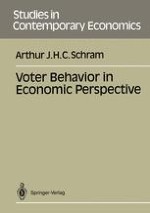1991 | OriginalPaper | Buchkapitel
Empirical Applications: The Demand for Public Goods
verfasst von : Dr. Arthur J. H. C. Schram
Erschienen in: Voter Behavior in Economics Perspective
Verlag: Springer Berlin Heidelberg
Enthalten in: Professional Book Archive
Aktivieren Sie unsere intelligente Suche, um passende Fachinhalte oder Patente zu finden.
Wählen Sie Textabschnitte aus um mit Künstlicher Intelligenz passenden Patente zu finden. powered by
Markieren Sie Textabschnitte, um KI-gestützt weitere passende Inhalte zu finden. powered by
In this chapter, two empirical applications of the model presented in Chapter 5 are discussed. Besides providing a test for the model, these allow for the determination of the original parameters. Of special interest is the estimation of the parameters concerning the relative preference for public versus private consumption possibilities. The estimation of preferences individuals have for public (non-marketed) goods, is a well-known problem in public economics. Due to the absence of markets true preferences are hard to determine (see Chapter 7). To obtain estimations for these preferences, four general lines of research have been followed, to wit: (1) median voter models (see Section 2.3), where typically a cross-section of communities with various levels of publicly supplied goods has been used to estimate the demand functions for those with median income (see, e.g., Borcherding and Deacon, 1972; Bergstrom and Goodman, 1973; Pommerehne and Frey, 1976; Courant et al., 1979); (2) survey methods, where demand is measured using various kinds of questionnaires (Strauss and Hughes, 1976; Gibson, 1980; Ferris, 1983; Hockley and Harbour, 1983); under this heading one may also place the preference revelation mechanisms designed by Clarke (1971), Tideman and Tullock (1976), and others.
